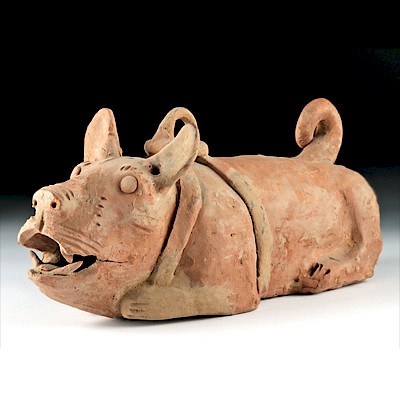Egyptian Wood Mummy Mask w/ Painted Details
Lot 7a
About Seller
Artemis Fine Arts
686 S Taylor Ave, Ste 106
Louisville, CO 80027
United States
Selling antiquities, ancient and ethnographic art online since 1993, Artemis Gallery specializes in Classical Antiquities (Egyptian, Greek, Roman, Near Eastern), Asian, Pre-Columbian, African / Tribal / Oceanographic art. Our extensive inventory includes pottery, stone, metal, wood, glass and textil...Read more
Estimate:
$2,500 - $3,500
Absentee vs Live bid
Two ways to bid:
- Leave a max absentee bid and the platform will bid on your behalf up to your maximum bid during the live auction.
- Bid live during the auction and your bids will be submitted real-time to the auctioneer.
Bid Increments
| Price | Bid Increment |
|---|---|
| $0 | $25 |
| $300 | $50 |
| $1,000 | $100 |
| $2,000 | $250 |
| $5,000 | $500 |
| $10,000 | $1,000 |
| $20,000 | $2,500 |
| $50,000 | $5,000 |
| $100,000 | $10,000 |
| $200,000 | $20,000 |
About Auction
By Artemis Fine Arts
Sep 13, 2018
Set Reminder
2018-09-13 10:00:00
2018-09-13 10:00:00
America/New_York
Bidsquare
Bidsquare : Ancient | Asian | Ethnographic - Fall Variety
https://www.bidsquare.com/auctions/artemis-gallery/ancient-asian-ethnographic---fall-variety-3432
Travel the world and back in time... Antiquities from Egypt, Greece, Italy and the Near East, Asian, Pre-Columbian, African / Tribal / Oceanic, Native American, Spanish Colonial, Russian Icons, Fine Art, much more! Artemis Fine Arts info@artemisgallery.com
Travel the world and back in time... Antiquities from Egypt, Greece, Italy and the Near East, Asian, Pre-Columbian, African / Tribal / Oceanic, Native American, Spanish Colonial, Russian Icons, Fine Art, much more! Artemis Fine Arts info@artemisgallery.com
- Lot Description
Ancient Egypt, Late Period, Dynasties 26 to 31, ca. 712 to 300 BCE. An elegant and refined mask with russet red painted flesh tones and black painted eyes and brows - as well as intricate linear and geometric motifs on the headdress, this hand-carved and hand-painted wooden sarcophagus mask displays quintessential Egyptian beauty. Notice those quixotic, large black outlined eyes - with deep-set lids framed by an arched browline that meets the bridge of its relatively naturalistic nose protruding above its closed mouth. The mask was an essential part of a mummy, placed over the head to provide an idealized image of the deceased. This particular mask is relatively small and was probably made for a child or a petite woman. Size: 7.5" H (19 cm); 11.125" H (28.3 cm) on included custom stand.
Mummy masks were principally used to protect the face of the deceased, but they could also act as a substitute for the mummified head in the case of loss or damage. The ancient Egyptians believed that the ba (often incorrectly translated as "spirit") could leave the tomb and travel freely in the world of the living. To make sure that upon returning it would recognize the mummy, whose face was hidden by layers of bandage, the mask functioned as a portrait. Nevertheless, most masks had idealized features and were rarely particularized portraits.
This mask and others like it were traditionally carved from cedar. Interestingly, cedar wood was not native to Egypt. Egypt did not have verdant forests filled with tall trees, and unfortunately most of its native lumber was of relatively poor quality. So they relied on importing to acquire hardwoods - ebony imported from Africa, cedar and pine from Lebanon. One fabulous obelisk inscription by Thutmose III attests to the luxury of treasured hardwoods. It reads as follows, "They brought to me the choicest products . . . consisting of cedar, juniper and of meru wood . . . all the good sweet woods of God's Land." (Obelisk inscription by Thutmose III - J. H. Breasted, Ancient Records of Egypt, Part Two, p. 321)
Provenance: private East Coast, USA collection
All items legal to buy/sell under U.S. Statute covering cultural patrimony Code 2600, CHAPTER 14, and are guaranteed to be as described or your money back.
A Certificate of Authenticity will accompany all winning bids.
We ship worldwide and handle all shipping in-house for your convenience.
#138430Expected age wear with abraded areas and old losses to the upper verso, peripheries of headdress, and high pointed areas as shown. Nice remains of original dowels in three perforations on verso. Good remaining pigments.Condition
- Shipping Info
-
All shipping is handled in-house for your convenience. Your invoice from Artemis Gallery will include shipping calculation instructions. If in doubt, please inquire BEFORE bidding for estimated shipping costs for individual items.
-
- Buyer's Premium



 EUR
EUR CAD
CAD AUD
AUD GBP
GBP MXN
MXN HKD
HKD CNY
CNY MYR
MYR SEK
SEK SGD
SGD CHF
CHF THB
THB














